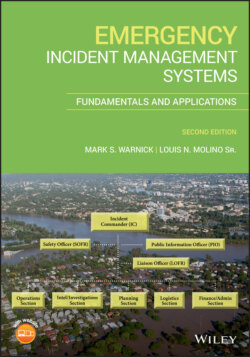Читать книгу Emergency Incident Management Systems - Mark Warnick S., Louis N. Molino Sr - Страница 77
3.13 Indonesia
ОглавлениеIndonesia is yet another country that has suffered many disasters, especially in the last 20 years. The use of the ICS method was initiated under the ASEAN agreement, and training was then supported by the US Government. The use of the ICS method is not complete in Indonesia (as of the writing of this book), but the use of this method in Indonesia has been gradually been gaining ground. Between 2004 and 2006 the US Department of State, Indonesian disaster/emergency managers were introduced to basic and then intermediate ICS courses through a series of workshops. These workshops were held in the region, although not initially in Indonesia. Later, in 2008, the US Forestry Service provided an ICS course specifically for Indonesian disaster/emergency managers in Jakarta (United States Agency for International Development [USAID], 2017).
Also, in 2008, the Indonesian government began to implement a system similar to the US version of the National Incident Management System (NIMS), but it was designed specifically for Indonesia. Much like the US version, the Indonesian version of NIMS utilized the ICS component as an important part of the NIMS method. While ICS can be used in a standalone capacity, it must be used if additional agencies are needed in a response. This has proven extremely beneficial for emergency incidents, drills, and exercises that have been undertaken by the Indonesian Government. After Action Reviews (AAR's) have identified only minor issues in the NIMS method and the ICS component, and these are addressed on a regular basis (USAID, 2017).
Since 2008, the Department of Justice's International Criminal Investigation and Technical Assistance Program (ICITAP) has conducted a series of basic, intermediate, and advanced ICS courses in Indonesia. These have been provided to at the national and provincial‐level governments. While the principal recipients for ICS training have been the Indonesian National Police, it has also included disaster/emergency managers and other first responders. When requested, the US government has also provided several direct trainings (as well as technical support) on the ICS method to local or provincial agencies who wish to create or hone their skills in disaster management (USAID, 2017).
In 2008, the National Agency for Disaster Management in Indonesia issued Regulation 10. Regulation 10 requires the use of the ICS method for all response agencies. In addition, ICS became part of a mandated training with required competency for new disaster/emergency managers based on Regulation 10. In 2016, the Indonesian National Agency for Disaster Management updated Regulation 10 by creating Regulation 3. This provided a more substantial framework to guide the implementation of ICS training courses to local and provincial governments (USAID, 2017).
Between 2012 and 2015, the Indonesian government created an in‐country ICS Steering Committee. The government also adapted ICS course materials to meet the needs of Indonesia and developed a training plan. With the assistance of several US agencies, they also arranged and provided ICS method train‐the‐trainer courses. In train‐the‐trainer courses, a variety of first responders from local and provincial agencies were taught how to deliver and teach ICS courses in their local area. Essentially, these individuals became master trainers for the ICS method. There was also consideration for the evaluation of the designation as a master trainer to ensure that there was an elevated level of competencies among those that deliver the courses. To ensure that this strategy was working, the use and evaluation of ICS was scheduled to be evaluated through conducting major disaster exercises (USAID, 2017).
Prior to master trainers, approximately 200 individuals in Indonesia had been trained per year since 2008. This has created a firm expansion in the use of ICS method in incident response. While the master trainer is in its preliminary stages, approximately 50 master trainers were certified in Indonesia by 2017. The organizations they represent include the disaster/emergency management agencies, the military, police, private industry (palm oil) organizations, forestry agencies (and organizations), and environmental agencies and organizations (USAID, 2017).
As of the writing of this book, officials in Indonesia are also considering mandating the implementation of the Hospital Incident Command System (HICS) through healthcare facilities in the country. This was brought about by the A 7.9 magnitude earthquake that struck the region in 2009 that caused mass confusion (Fuady, Pakasi, & Mansyur, 2011). While the considered mandate and implementation appears to be ongoing, it seems that Indonesia is moving in that direction, if they have not already completed the transition.
